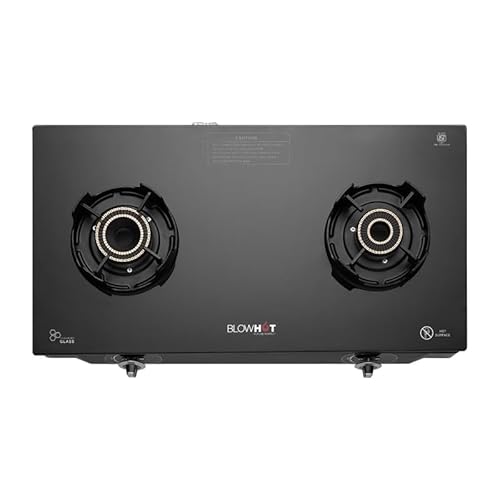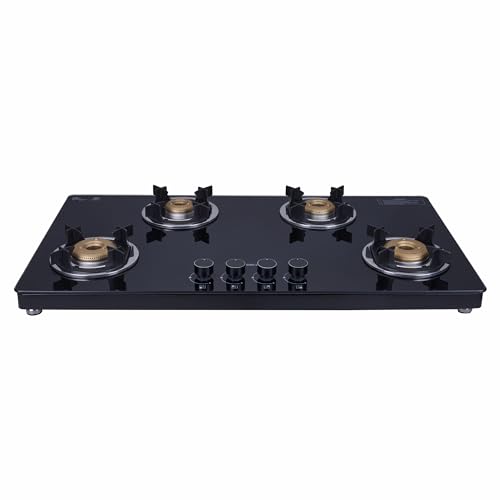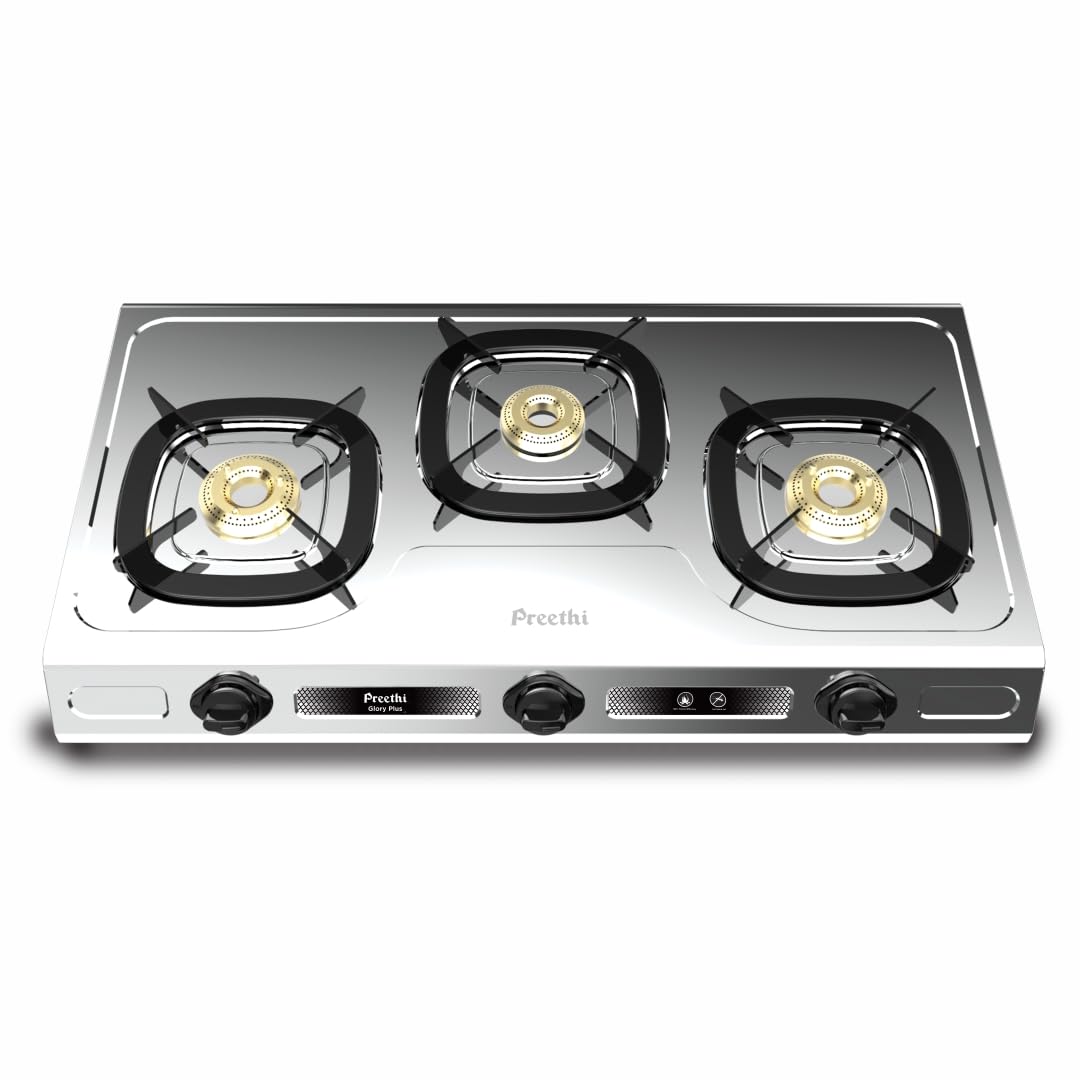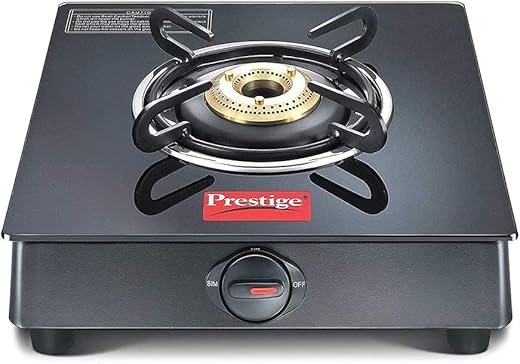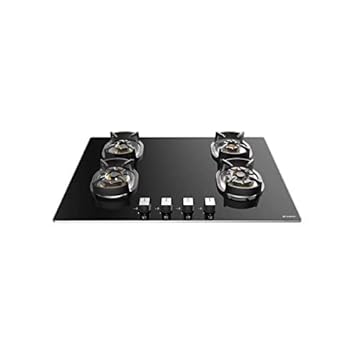Top 10 Fuel-Efficient Gas Stoves Under ₹15,000 in India
In an era of rising LPG costs, choosing a high-thermal-efficiency gas cooktop is one of the smartest investments you can make for your kitchen. A truly efficient stove not only reduces your monthly fuel bill but also cuts down cooking time.
We have compiled a list of the highest-efficiency gas cooktops available in the Indian market for under ₹15,000, focusing on essential features like superior brass burners, robust build quality, and modern convenience.
Today’s Trending Gas Cooktops Under ₹15,000
BLOWHOT 2 Tornado Brass Burner Auto Ignition Gas Stove - Toughened Glass Cook Top -ISI certified- Black Powder Coated Body...
Free shipping
- UNIQUE DESIGNED KNOBS : Unique design knob in burner will give elegant look and enhance the beauty of the kitchen.Ga
- TOUGHEND GLASS TOP : Toughened Glass Top along with black powder coated body makes a unique combination of strength and elegance.
- GAS STOVE TYPE : 2 Burner Auto Ignition. HEAVY VESSEL SUPPORT : Stay cool & indulge in a hassle free cooking even when a lot of guests are arriving as BlowHot Cook Top supports heavy and big vessels.
Prestige IRIS Toughened Glass-Top 3 Brass Burner LPG Gas Stove | Black Spill Proof Design | Ergonomic Knob | Tri-Pin...
Free shipping
- Spill Proof Design - For hastle free cooking and a Cleaner Kitchen
- Tri-Pin Burners - For high Efficiency and faster cooking
- Ergonomic Design - For easy handling and Maintainance
- Toughned Black Glass top - Resists Scratches and withstands everyday wear and tear
- 2 Years Manufacturer Warranty
Prestige Royale Plus GT 03L Toughened Black Glass Top Gas Stove(Manual, 3 Brass Burners, Black, Baati/Tandoor Stand Inside)
Free shipping
- Toughened Glass- Superior toughened black glass top resists scratches and withstands everyday wear and tear
- Sturdy Pan Supports- The robustly designed, long-Lasting pan supports ensures vessels stay steady, while cooking
- Thoughtful Design- Spill-Proof design for a cleaner kitchen
- TRI-PIN Brass Burners- Signature brass burners ensure long-lasting performance and efficient usage of LPG
- Ergonomic Knob design- Makes turning the knob easy on the fingers
Sujata Sterno Auto Ignition Gas Stove | 9 Years Warranty | Gas Stove 3 Burners Steel, Stove 3 Burner, SABAF,...
Free shipping
- AUTO IGNITION SYSTEM: Features convenient electronic ignition for quick and effortless lighting of the burner without matches or lighters
- CONSTRUCTION: Made from premium stainless steel for superior durability and resistance to rust and corrosion
- PORTABLE DESIGN: Compact and lightweight countertop burner perfect for outdoor cooking, camping, or as an extra cooking surface
- EFFICIENT PERFORMANCE: Powerful gas burner provides consistent heat distribution for various cooking needs
Butterfly Smart 3 Burner Glass Top Gas Stove | Manual Ignition | Scratch Resistant Toughened Glass | Brass Burners |...
Free shipping
- Ergonomically designed with a precisely angled metal frame featuring a diamond cut design, this stove provides effortless access to controls, enhancing your cooking experience
- 6mm Ultra thick Glass that can withstand heavy weight and durable for a lifetime Glass is masterfully crafted through a quenching technique with tempratures soaring upto 650 degrees where every glass is tested through a 1Kg Iron Ball Drop Test to ensure quality & durability
Prestige Marvel Plus 4 Burner GTM 04 SQ Glasstop Gas Stove|Superior Toughened Glass|Jumbo Brass Burner|360 Degree Revolving Nozzle|Spill Proof Design|5...
Free shipping
- SUPERIOR TOUGHENED BLACK-GLASS TOP: Resists scratches and withstands everyday wear and tear.
- 360° REVOLVING NOZZLE : Convenience of connecting hose pipe from any direction with the 360° revolving nozzle.
- ERGONOMIC KNOB DESIGN: Makes turning the knob, easy on the fingers.
- SPILL-PROOF DESIGN: For hassle-free cooking and a cleaner kitchen with Tri-Pin Brass Burners comes in various sizes for all your cooking needs.
Sunflame Pride 3 Burner Gas Stove 68.5 cm Wide | 2-Years Product Coverage | 2 Small and 1 Medium Brass...
Free shipping
- Elegant Design: Sunflame Pride 3-Burner Gas Stove features a stylish design with a glass top, enhancing the elegance of any kitchen exuding grace and refinement.
- Durable and Stylish Knobs: Crafted from heat-resistant nylon material, the knobs of this cooktop enable effortless adjustment of flame intensity or heat levels, combining durability with style.
- ISI Certified LPG Gas Stove: With its glass top gas stove is safe and reliable for LPG use. It meets the BIS standards for quality and durability, holding the ISI certification.
Butterfly Aeroline 3 Burner 3-Star Rated Glass Top Gas Stove | Wind Shield | Leak Proof European Valve
Free shipping
- Changing the way you cook: Idea first series that is thoughtfully designed understanding your real life problems to arrive upon a solution that would change the way you cook
- Engineered for Efficiency – The first 3-Star Rated Glass Top Stove in India, designed to optimize gas usage and cut down on your household expenses by one gas cylinder per year.
- Heavy Duty Construction - Crafted with a rust-resistant MS structure and HR-coated brass burner for stable heat output and reduced maintenance
Glen Gas Stove 4 Burner Stainless Steel Gas Stoves | Extra Wide Design | 1 High Flame 3 Brass Burners...
Free shipping
- : Crafted from high-quality stainless steel, ensuring long-lasting performance and resistance to corrosion, rust, and wear.
- : With Ample space of 635x580 mm, it provides room for multiple pots and pans simultaneously, perfect for large gatherings or preparing elaborate meals.
- : Equipped with Four brass burners, 1 high flame, 1 big and 2 small burner for diverse cooking requirements
- : Robust construction with sturdy legs ensures stability and safety during use, offering a reliable platform for your culinary adventures..
Pigeon by Stovekraft Aster 3 Burner Gas Stove with High Powered Brass Burner Gas Cooktop, Cooktop with Glass Top and...
Free shipping
- High efficiency brass burner
- Strong tubular legs for firm grip
- Easy to maintain and clean
- Uniquely Designed Pan Support For Better Balance
- Unbreakable ABS Smooth Knobs
Prestige IRIS Toughened Glass-Top 2 Brass Burner LPG Gas Stove | Black | Spill Proof | Ergonomic Knobs | Tri-Pin...
Free shipping
- Ergonomic Design - For easy handling and Maintenance
- Spill Proof Design - For hastle free cooking and a Cleaner Kitchen
- Toughned Black Glass top - Resists Scratches and withstands everyday wear and tear
- Includes: 1 x Prestige IRIS LP Gas table (GTI 02 With powder coated Body, Glass top, 2 Brass Burners
- 2 Years Manufacturer Warranty
Prestige Royale Quadra 3Burner Gas Stove|Superior Toughened Glasstop with 5-Year Warranty| 3-Way Nozzle Design|Tri-Pin Jumbo Burner |Uniquely Designed Pan Support...
Free shipping
- SAFETY: The advanced toughening process ensures high impact and temperature resistance adhering to international safety standards DURABILITY: This glass is highly durable and is tested to withstand bigger thermal shocks and mechanical impacts than any other glass"
- CONVENIENT COOKING: The specially designed, long-lasting pan support ensures the vessels stay steady while cooking WARRANTY: The glass cooktop offering a dependable 5-year warranty on the glass and 2-year warranty on the product
Glen 4 Burner Ultra Tuff Stainless Steel LPG Gas Stove | Silver | Forged Brass Burner | Revolving Inlet Nozzle...
Free shipping
- : Built with an easy-to-clean, durable Ultra Tuff stainless steel body in a sleek silver finish, designed to withstand the rigors of daily use and maintain its shine.
- : Equipped with 4 high-quality forged brass burners, including 1 high flame, 1 big, and 2 small burners, for versatile and efficient cooking options to suit all your needs.
- : Strong and sturdy 5mm thick pan supports provide reliable support for heavy and large utensils, making it easy to cook with large pots and pans.
Prestige Marvel Glass Top 4 Burner Gas Stove, Manual Ignition, Tempered Glass, Black
Free shipping
- Gas stove type: Manual; Burner material: Brass; Size of the burner: 2-Small,1-Medium,1-Large; Material of the body: Powder Coated Body; Material of the top: Toughened Glass; Size of the gas stove (in cm): 63.5 x cm 60 x cm 15.5 cm; Colour: Black
- Warranty: 2 Years on Product; Covered in warranty: Manufacturing defect and others mentioned in the user manual; Not covered in warranty: Mentioned in the user manual
Butterfly Magnum Stainless Steel Liquefied Petroleum Gas Stove, 2B
Free shipping
- Hot Forged Jumbo Burners
- Adjustable Leg Stand for Comfort Cleaning
- Mirror Finished Stainless Steel Body
- Widely Spaced Burners for placing variety of large utensils
- 2 MM Thick Rust Proof Body for Lifelong Durability
MILTON Premium 2 Burner Black Manual Ignition Glass Top Gas Stove, (ISI Certified)
- It comes with a Premium finish 6mm Toughened Black Glass Top, It offers a rust resistance texture while delivering long lasting performance.
- Equipped with 2 Fuel Efficient Tri Pin Brass Burners; 1 Small & 1 Big for your varied needs.
- Smoothly operating high quality bakelite knobs for that firm grip and hassle free usage in the longer run.
- It has black mild steel powder coated body and comes with Anti-Skid Rubber Legs.
Haute Evoque Series 2.0 Black 4 Burner Manual Ignition Glass Gas Stove |8mm Atom Glass || Door Step Service |...
Free shipping
- Battle Ready - Efficiency Test , Leak Test , Pressure Test , Corrosion Test
- Signature Haute Burners , Italian precision valves , Heavy Duty pan support , Designer Knobs, Premium toughened glass
- Black Haute Design – 31.5x19x3 inches – A perfect modern look for your Kitchen
- 2 year Manufacturing warranty , 5 year warranty on Burners
- Please contact for Installation within 24-48hrs of purchase. Installation will be done within 72hrs. Warranty is only applicable after registration with Haute Kitchen on the registered no.
Elica Slimmest 4 Burner Gas Stove | 904 CT VETRO 2J (TKN CROWN DT MI) | Forged Brass Burners |...
Free shipping
- Forged Brass Burners: Delivers high durability and uniform heating with 2 jumbo, 1 medium, and 1 small burner for varied cooking needs.
- Toughened Glass Top: Heat and stain resistant black toughened glass with a 5-year warranty ensures durability and elegance.
- Double Drip Trays: Removable trays absorb spills for easy cleanup - keeps your kitchen mess-free after every meal.
- Crown-Shaped Euro Coated Pan Supports: Stable and long-lasting support for heavy cookware and everyday utensils.
Sujata Premium Gas Stove | 9 Years Warranty | 4 Burner Gas Stove Glass Top, SABAF, ISI Certified, LPG &...
Free shipping
- 8mm Ultra-Thick Toughened Glass – Designed for long-lasting durability, added safety, and a premium look to enhance kitchen’s style.
- Warranty: 9 Years Warranty on Complete Products including Toughened glass.
- SABAF Gas Valve for Longer Life & Easy Conversion from LPG to PNG
- Rigid, Stable and Sturdy Pan Supports with Flame Guard for Gas Saving Ergonomically Designed Alloy Knob5G Designed Forged Brass Burner with Direct Flame for Indian Style Cooking
Whirlpool Hob 4 Burner Crystal Glass Auto Ignition Gas Stove (Elite Hybrid 704 Mt Gas Hob), Black
Free shipping
- High Efficiency Multi-ring Burner: The intellicook multi flame Sabaf Italian Enameled black burner hobs offer high efficiency flame levels best suited for Indian cooking needs with high flame and sim options.
- Heat Resistant Knobs: The knobs are made heat resistant for a longer cooking durations unique to Indian cooking.
- Lifetime Warranty: Whirlpool offers 10 years warranty on toughened glass and 5 years on burners and gas valves covering the lifetime of the appliance.
Beyond Appliances Dorado 3 Burner Smart Glass Hobtop Gas Stove | Auto Ignition | Digital Timer | Flame Failure Device...
Free shipping
- Smart Digital Timer: Say goodbye to overcooked meals and kitchen chaos. Our advanced digital timer ensures precise cooking times, allowing you to cook with ease.
- Flame Failure Device for All Burners: Your safety is our top priority. Our innovative flame failure device automatically shuts off the gas supply if the flame goes out due to a gust of wind or spillage, providing safety to you and your loved ones.
Elica Slimmest 3 Burner Gas Stove | 773 CT VETRO (Slim Line SPF) | Forged Brass Burners | Square Enameled...
Free shipping
- Compact Slim Line Design: Ultra-slim profile allows space-saving installation in any modern kitchen setup.
- Forged Brass Burners: Durable and high-performing with 3 burner sizes - 1 Jumbo, 1 Medium, and 1 Small - to meet diverse cooking needs.
- Square Enameled Pan Supports: Offers firm and stable placement for cookware of all sizes, ensuring even flame contact and consistent cooking.
- Stylish Knobs & Manual Ignition: Ergonomic knobs with smooth rotation and reliable flame control; manual ignition system for traditional flame lighting.
Prestige Magic plus Toughened Glass-Top(Long)4 Brass Burner LPG Gas Stove (GTMP-04L)| Black Spill Proof Design | Ergonomic Knob | Tri-Pin...
Free shipping
- Spill-Proof Design-Stylish design with attractive finish
- Ergonomic Knob Design-The knobs are elegantly designed and are easy to use
- Superior toughened black glass – durable and elegant
- Tri-Pin brass Burners – highly efficient – heats evenly – long-lasting performance
- Product warranty - 2 years (including glass), Made in India, Compact Sleek form factor
- Powder Coated body, Robust and premium Materials used
Elica Vetro Glass Top 4 Burner Gas Stove (CT VETRO 460 BLK)Open,Black
Free shipping
- 4 Premium Brass Burners (2 Large, 2 Small) - Experience fast, even heat distribution for everything from daily meals to festive feasts. Two large and two small burners let you cook multiple dishes at once, saving time and energy.
- Built to Last & Easy to Clean - Elegant black glass surface that is heat and scratch resistant, offering long-lasting durability and effortless cleaning.
- Extra Strength Where It Matters Most - A robust stainless steel plate beneath the glass adds exceptional stability and support, ensuring your stove remains sturdy for years of heavy use.
Top 10 High-Efficiency Gas Cooktops Under ₹15,000 (India 2025)
The table below features the most reliable and fuel-saving models known for their performance in Indian kitchens:
| Rank | Brand | Model Highlights | Burners | Approx. Price (INR) | Key Efficiency Feature |
| 1 | Blowhot | Premium Tornado | 3/4 | ₹6,000–₹12,000 | Tornado Burners (Up to 30% fuel savings claimed) |
| 2 | Vidiem | TUSKER PULSE / TUSKER | 3 | ₹9,000–₹12,500 | Heavy-Duty Forged Brass and anti-corrosive gas valves |
| 3 | Faber | Jumbo/Remo Series | 3/4 | ₹7,000–₹12,000 | Jumbo & Multi-Flame Burners for large utensils |
| 4 | Glen | 3047 GT / 3054 GT | 3/4 | ₹6,000–₹13,000 | Forged Brass Burners with high-quality toughened glass |
| 5 | Prestige | Marvel Plus / Svachh Neo | 3/4 | ₹7,000–₹11,000 | Schott Glass (select models), Spill-proof design, reliable brass burners |
| 6 | Elica | Vetro Series | 3/4 | ₹3,500–₹8,000 | Heavy-duty brass burners with Euro-coated grids for stability |
| 7 | Hindware | Lorenzo 3B | 3 | ₹7,000–₹10,000 | Heavy-duty brass, stylish design, ISI certified components |
| 8 | Sunflame | GT Pride / Crystal Nova | 3/4 | ₹6,000–₹9,000 | Tri-pin brass burners, Spill-proof design |
| 9 | Butterfly | Smart Glass Top | 3 | ₹4,000–₹7,000 | Value for money, ISI-certified brass burners, user-friendly |
| 10 | Bosch | Select Cooktops | 3/4 | Up to ₹15,000 | SABAF Burners (on premium models) known for higher thermal efficiency |
Swipe left or right to see the whole table on mobile devices.
Why These Cooktops Guarantee Higher Efficiency
The term “efficiency” in a gas cooktop refers to its thermal efficiency—the percentage of heat energy from the gas that is actually transferred to the cooking vessel, as opposed to being lost to the surroundings. Look for stoves with a thermal efficiency of 68% and above (as per BIS standards, though models with higher figures exist).
Here are the key factors that make the listed models fuel-efficient:
1. The Power of Brass Burners (The Core Component)
- Superior Heat Transfer: Brass has a significantly higher thermal conductivity than the commonly used aluminium or cast iron. This means heat is transferred faster and more uniformly to the cooking vessel, reducing the time the gas is on.
- Corrosion Resistance: Brass resists rust and corrosion far better than cast iron, ensuring the burner ports (the small holes) remain clean and the flame profile stays optimal over the lifespan of the stove, preventing gas wastage.
- Forged Brass Advantage: Models like Vidiem and Glen use “Forged Brass” burners, which are denser and more durable, further enhancing their heat retention and longevity.
2. Advanced Burner Technology
- Multi-Flame & Triple Ring Burners: Found in models from Faber and Blowhot, these burners are designed to distribute heat evenly across the base of large utensils (like a kadhai or pressure cooker). They generate multiple rings of flame, maximizing the surface area heated and optimizing fuel use for faster boiling and cooking.
- Tornado Burners: Featured by Blowhot, this design generates a swirling, focused flame. This reduces heat loss to the surrounding air and directs more heat directly to the base of the vessel, resulting in significant claimed fuel savings.
3. Convenience Features that Save LPG
- Auto Ignition: Found in premium models from Glen and Faber, auto-ignition eliminates the need for matchsticks or lighters. This saves gas that would otherwise be wasted waiting for a separate ignition source, especially during multiple starts.
- Toughened Glass Top: A quality glass top (like Schott glass in Prestige models) is not directly an efficiency feature but aids in maintenance. Easy cleaning ensures that grime and spills do not block gas ports, which can significantly reduce efficiency over time.
- Sturdy Pan Supports: Heavy, Euro-coated, or cast iron pan supports ensure that the cooking vessel sits at the optimal distance from the flame. If the vessel is too high or too low, thermal efficiency drops dramatically.
Critical Buying Checklist (Must-Know Tips)
Before finalizing your purchase, consider these vital points:
| Feature | Why it Matters for Efficiency & Safety |
| Burner Material | Always prefer Brass or Forged Brass. They are the gold standard for thermal efficiency and durability in India. |
| Number of Burners | Choose based on your family size. A 3-burner model is ideal for a nuclear family (3-4 people), while a 4-burner is best for larger families, enabling multitasking and saving time/fuel. |
| Certification | Look for the ISI Mark (BIS Certified). This ensures the stove meets Indian safety and minimum thermal efficiency standards (which is typically ≥68%). Never compromise on this. |
| Ignition Type | Manual is cheaper and reliable. Auto Ignition offers convenience and minor gas savings but adds to the upfront cost. |
| Pan Support | Check for Euro-coated or Cast Iron supports. They are sturdier, offer better grip, and maintain the correct distance from the flame. |
| Warranty | A good brand like Prestige or Faber will often offer a 2-year comprehensive warranty on the product and a 5-year warranty on the glass. |
View in Sheets
Frequently Asked Questions (FAQs) – Best Fuel-Efficient Gas Stoves in India Under ₹15,000 (2025 Buying Guide)
These frequently asked questions address user intent and major purchasing aspects (including the new 2026 BEE standards).
Section 1: Fuel Efficiency & Standards
Q1. What is ‘thermal efficiency’ in a gas stove, and why is it the most important factor for fuel-saving?
A. Thermal efficiency is the percentage of the heat generated by the burner that is actually transferred to the cooking vessel. In India, this is the official metric used by the Bureau of Energy Efficiency (BEE) to rate gas stoves. A higher thermal efficiency (e.g., 76% vs 68%) means less LPG is wasted as heat escaping into the air, directly leading to significant fuel savings and lower running costs.
Q2. How much LPG can a high-efficiency gas stove save annually?
A. Moving from an older or low-efficiency stove (around 65-68% efficiency) to a high-efficiency model (74-76% efficiency or 5-Star rated, effective Jan 2026) can result in substantial savings. Industry reports and manufacturer claims for high-efficiency models, such as the BPCL Hi-Star series, suggest a potential saving of up to one full 14.2 kg LPG cylinder per family per year. This translates to both cost savings and a reduction in carbon emissions.
Q3. What are the new BEE Star Ratings for LPG Stoves in India (effective January 2026)?
A. The Bureau of Energy Efficiency (BEE) has made star labeling mandatory for domestic LPG stoves starting January 1, 2026. This is a major change to help consumers identify the most fuel-efficient models. The ratings are based on thermal efficiency:
- 1 Star: ≥68%
- 3 Star: ≥72% and <74%
- 5 Star: ≥76% (Highest Efficiency)
When buying in 2025, look for models that advertise high thermal efficiency (over 74%) to ensure you are purchasing a future 4 or 5-Star compliant stove.
Q4. What is the ideal number of burners to maximize fuel efficiency for a typical Indian household?
A. The most fuel-efficient choice depends on your cooking habits:
- 2-Burner Stoves: Best for smaller families (1-2 people) with basic cooking needs. They generally have the lowest total gas consumption.
- 3-Burner Stoves (Most Popular): Ideal for the average Indian family (3-5 people). They balance utility and efficiency, allowing multiple dishes to be cooked simultaneously without excessive heat loss from unused burners.
- 4-Burner Stoves: Best for large families or those who cook elaborate meals, as the fuel saving from efficiency outweighs the occasional use of the extra burner.
Section 2: Burner & Build Quality
Q5. Are Brass Burners or Aluminium Burners more fuel-efficient and durable?
A. Brass burners are generally superior and are recommended for the best fuel efficiency and durability. | Feature | Brass Burners | Aluminium Burners | | :— | :— | :— | | Durability | Excellent. High resistance to corrosion and heat. Long lifespan. | Good. Lighter and more affordable, but may corrode faster. | | Efficiency | Excellent heat retention and even heat distribution. | Heats up quickly, but may not retain heat as effectively. | | Cost | Higher initial cost. | Lower initial cost. |
Q6. What is the difference between standard Brass Burners and Forged Brass Burners?
A. Forged brass burners are made using high pressure and heat, resulting in a denser, stronger, and smoother brass component with a tight grain structure. This process reduces imperfections and increases resistance to high temperatures and prolonged use, making them significantly more durable and slightly more consistent in heat delivery than standard cast brass burners. If budget permits (within the ₹15,000 range), choose forged brass for the best longevity.
Q7. Which type of glass top is best for durability: Toughened or Tempered Glass?
A. Both terms are often used interchangeably for gas stove tops, and generally refer to Toughened Glass. This glass is chemically and thermally treated to increase its strength compared to normal glass. When buying, ensure the glass is thick (typically 6mm to 8mm) and certified by the BIS (Bureau of Indian Standards) mark for safety.
Section 3: Key Features & Maintenance
Q8. Is an Auto Ignition system worth the extra cost over a Manual Ignition?
A. Yes, for convenience and safety.
- Auto-Ignition: Uses a built-in spark (electric or battery-operated) to light the burner instantly with a turn of the knob. It’s more convenient, reduces the risk of gas leaks from delayed ignition, and eliminates the need for external lighters/matchboxes.
- Manual Ignition: Requires an external source (lighter/matchstick). While cheaper initially, it can lead to slight gas wastage if the lighter is not applied immediately, and is less convenient.
Q9. What are the essential safety features to look for in a fuel-efficient gas stove?
A. Prioritize these features:
- BIS Certification (IS 4246:2002): Mandatory safety and performance standard in India.
- Pan Supports: Should be robust (cast iron or heavy gauge powder-coated steel) to ensure stability for heavy Indian cookware.
- Nozzles/Gas Inlet: Should be durable and leak-proof.
- Anti-Skid Feet: Essential for a stable and safe cooking experience.
Q10. How should I maintain my fuel-efficient gas stove to ensure long-term savings?
A. Simple maintenance is key to maintaining efficiency:
- Clean Burners Regularly: Clogged burner holes reduce gas flow and efficiency. Clean them with warm water and soap if the flame is orange or uneven.
- Check for Blue Flame: A high-efficiency stove will have a stable, bright blue flame. A yellow or orange flame indicates incomplete combustion, which means wasted gas and lower efficiency.
- Use the Right Cookware: Use flat-bottomed vessels that fully cover the burner. Using a pressure cooker or covering the pan with a lid saves gas and cooking time.
- Periodic Servicing: Get the gas stove professionally serviced every 1-2 years to ensure the internal components (mixing tubes, nozzles) are clean and calibrated correctly.
Final Verdict
For the absolute best balance of high thermal efficiency, modern design, and long-term durability under the ₹15,000 budget, we recommend focusing on models from Vidiem, Blowhot, and Glen that specifically mention Forged Brass or Tornado Burners.
These cooktops use superior burner technology that is proven to deliver excellent heat transfer, ensuring you get the fastest cooking times and maximum savings on your monthly LPG cylinder.
Gas Cooktops: Today’s Top Deals

Preethi Stylo Steel 3 Burner Gas Stove |Curved & Sleek design| Heavy Brass Burner| Ant Guard Jet | Removable Drip Tray

Preethi Shine Stainless Steel Gas Stove 4 Burners I Manual Ignition I ISI Certified I 2 Year Warranty

Preethi Fino Stainless Steel Manual 2-Burner Gas Stove | Jointless Body | Removable Drip Tray | Heavy Brass Burner| Ergonomic Knobs

Preethi Elda Stainless Steel 2-Burner Gas Stove | Jointless Body | Bigger Body Size| Removable Drip Tray | Heavy Brass Burner|Gas Lighter…

Khaitan Combo – 1 unit Burner Jio Tougned Glass Gas Stove + 1 unit HF Kitchen Lighter + 1 unit HF LPG Hose Pipe (1.5 mtr) (1 Bur (1B Jio & Hose…

2 Burner Metro Stainless Steel Manual Gas Stove 1 Year Warranty (ISI Certified & BIS Approved) (2 Burner)

Khaitan 2 Burner Nano Black Toughened Glass | LPG Cooktop I Manual Ignition Stove| Ergonomic Knob | with 1 Year Warranty | Pan India Service | LP…
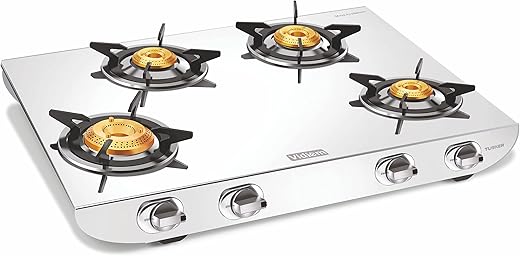
Vidiem Gas Stove S4 236 A Tusker (Black) | Stainless Steel 4 Burner frameless Gas Stove | Manual Ignition | Safety, Reliability, High Efficiency

1000w Hot Plate Charcoal Burner Sigdi Electric Stove Insant Coal Burner Coffe Maker, Boiling Water, Making Tea 5 minutes Coal Heater – Black

Thermador EcoFlame 4 Burner Gas Stove Glass Top Manual Ignition | Brass Plated Burners | Four Burner Gas Stove | LPG | ISI Certified | 1 Yr…
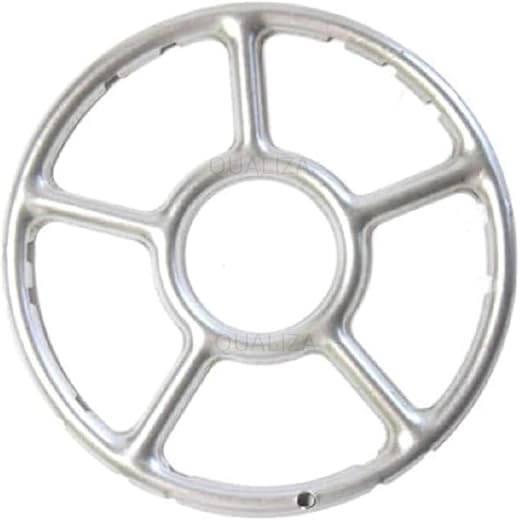
Gas Stove Burner Stand – Non-Slip Support Ring for Moka Pot, Pan, Wok & Coffee Pot | Gas Range Auxiliary Rack & Accessories | Kitchen Utensils (1)

Amazon Basics 2 Burner LPG Gas Stove with Toughened Glass-top | Tri-pin Brass Burners with spill-proof and easy-clean design | Ergonomic Knobs,…

Sunflame Diamond 3 Burner Gas Stove | 1 Medium and 2 Small Brass Burners | 2-Years Product Coverage by Sunflame | Heat Resistant Ergonomic Knobs |…

Prestige Svachh Neo 3 Burner Gas Stove | Easy Clean Design-3 Liftable Burners | Toughened Glass Top | Tri-Pin Brass Burners | 1 Jumbo Burner |…

Prestige Vectra 4 Burner Glasstop Gas Stove|Superior Toughened Glass|Jumbo Brass Burner|3-Way Gas Inlet|360 Degree Revolving Nozzle|10 Years…

Prestige Iris Plus 2 Burner Auto Ignition Gas Stove | Toughened Glass Top | Tri-Pin Brass Burners | Ergonomic Knob | Black | 2Y Warranty | ISI…

Sunshine Falcon Gas Stove | 3 Burner Chulha, Steel Gas Stove, Warranty By Sunshine – 5 Year On Burner, Manual Ignition | 5G technology, LPG (Silver)

Khaitan 3 Burner Draw Double Decker (with party cooking burner) Stainless Steel Manual Gas Stove (3 Burners)
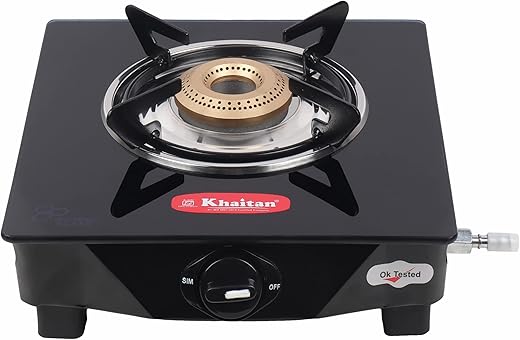
Khaitan 1 Burner BP Jio Black Toughened Glass | LPG Cooktop I Manual Ignition Stove| Ergonomic Knob|with 1 Year Warranty | Pan India Service| LP…
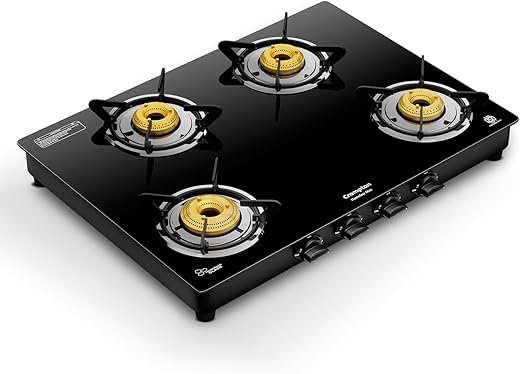
Crompton FlameStar Max 4 Burner Glass Top LPG Gas Stove | 1 Jumbo & 3 Medium Brass Burner | Max Space | Easy Cleaning | Toughened Glass| Tri Pin…
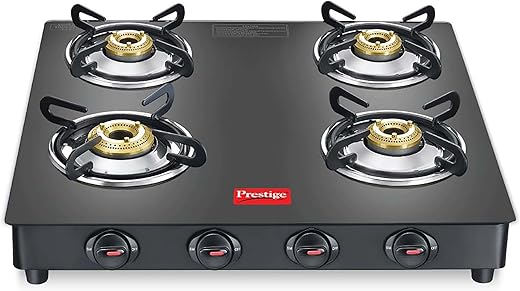
Prestige Magic Plus Gtmp 04 Sq Lp Open Gas Stove(Black, With Powder Coated Body, Glass Top And 4 U Brass Burners)

Faber Glass, Mild Steel Hobtop Utopia HT 804 BR CI Auto Electric Ignition Glass Top 4 Brass Burner (Black)
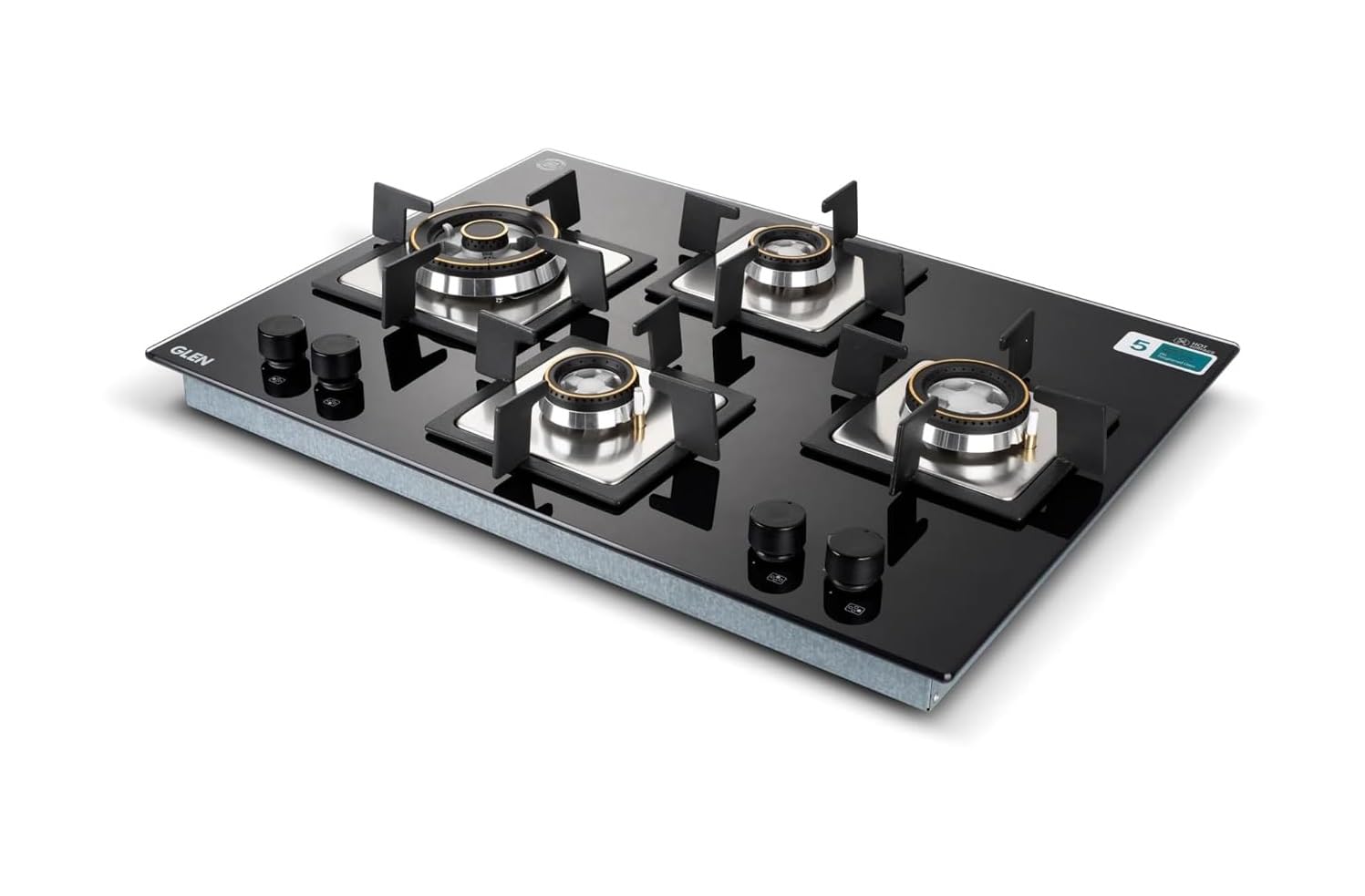
Glen Built In Hob 4 Burner Gas Stoves Auto Ignition 8 MM Toughened Glass Black Forged Brass Burner with Double Ring Flame Hob Gas Stove 4 Burner

